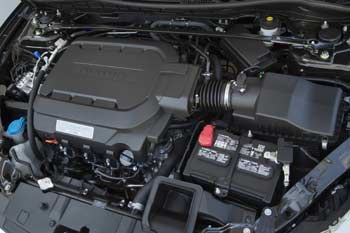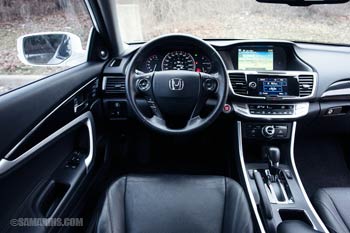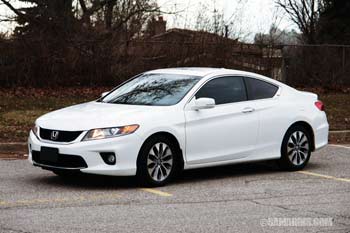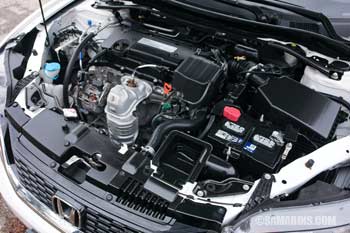2013-2017 Honda Accord: pros and cons, common problems
By Vlad Samarin Updated: April 02, 2023
The ninth generation Accord comes as a classy mid-size sedan or a stylish coupe. It has a front-wheel drive and comes with a 2.4-liter 4-cylinder or a 3.5-liter V6.4-cylinder models come with a CVT transmission. The V6 trim levels offer a conventional 6-speed automatic. A 6-speed manual transmission is available with either engine.
The Accord is generally reliable, but there are a few problems to watch out for. Let's start with pros and cons.
Pros:
- Classy looking sedan, stylish coupe.
- 5-Star overall NHTSA safety rating.
- Fuel economy: the 4-cylinder Accord is rated at 27/35 mpg (2015), the Accord hybrid delivers 49/45 mpg.
- You can buy it with a strong 278-hp V6.
- General reliability.
- Balanced handling.
- Interior comfort, fit and finish.
- Holds its value well.
- Can last long with good care.
- Available with a manual transmission.
- The ride is on the firm side and some road/wind noise is noticeable.
- Some interior materials are not of the top quality.
- In a V6, the timing belt and water pump will need to be changed at around 100,000 miles, which is not cheap.
- Starting, electrical problems.
- Undersized battery in 4-cylinder models.
- Paint chips easily.
Examples of the common problems: A weak battery or corroded battery terminals can cause a variety of problems, including lack of steering assist, no start and other electrical issues and warning lights. On top of that, the battery in the 4-cylinder Accord is small and doesn't last as long as a regular-sized battery. Replacing the battery costs from $135 to $310. There was a recall to replace the 12-volt battery sensor. Check NHTSA website for recalls.
In a separate issue, the Honda service bulletin TSB16-002 describes a problem with the starter motor in the 2013-2015 Accord V6 auto, where it makes a grinding noise at startup. The repair involves replacement of the starter motor and repositioning of the torque converter.
Advertisement
Several Honda Accord owners mentioned the wind noise coming from the door. Honda has issued TSB 15-087 on this problem. Of course, performing this TSB will reduce the noise but will not eliminate it completely. Watch these Youtube videos.
We found several reports that the infotainment system / navigation / reverse camera freezes or stops working. Some owners say that the dealer reset the system by disconnecting the battery to solve the issue. Several owners reported that a software update at the dealer fixed some of the bugs. In some cases, the reverse camera or the infotainment system unit had to be replaced. We should note that problems with the infotainment systems are very common in many modern cars and are not limited to Honda.
There have been a number of complaints at the NHTSA website about LED DRL lights burning out inside the headlights in the 2016 Accord. Honda has issued the service bulletin 19-042 (and extended the warranty) on this problem for some 2016-17 models. The repair involves replacement of the headlight unit(s), which is quite expensive if not covered by the warranty.
2013-2017 Honda Accord Summary: Despite the problems mentioned above, the Accord is one of the best mid-size cars on the market. Many other family sedans have more problems. As of April 2023, Consumer Reports rates all model years of this generation Honda Accord as 'Recommended'. The majority of reported problems are related to 2013 and 2014 models. Among competitors, we would recommend the Toyota Camry and the 2014+ Mazda 6. Read also: Pros and cons of buying a car with a CVT transmission.
What to look for when buying a used Honda Accord: Watch out for problems with the starter. The car should start on the first try without grinding or other noises. If the battery is old and needs to be boosted, it might need to be replaced soon. Check both headlights; if the LED DRL is dim or flickering, the whole headlight unit might need to be replaced. See if the reverse camera, navigation and other features of the infotainment system are working. Check all areas of the touchscreen.
Watch out for warning lights or messages that are staying on on the dash after the vehicle is started. Some problems might be expensive to fix; for example the Forward Collision Warning system. Watch out for signs of oil leaks under the vehicle. During the test drive, see if the CVT transmission "shifts" smoothly when accelerating from a stop. Watch out for a delay when the transmission is engaged or a shudder during acceleration.
Watch out for electrical power steering issues such as pulling to one side or the steering wheel not returning to the center position.
Check with a Honda dealer if all of the recalls and campaigns have been completed. This forum DriveAccord.net has some useful info. Read also: How to inspect a used car - illustrated guide.
Similar cars:
Honda Accord 2008-2012
Toyota Camry 2012-2017
Mazda 6 2014-2019
K24W Earth Dreams Engine: The primary engine choice is the 185-hp 2.4L K24W Earth Dreams DOHC i-VTEC. It's a different engine from the previous K24 of the 2012 Accord. In K24W the intake is now placed at the back, while the exhaust manifold is at the front.
The K24W engine has a higher compression ratio (11.1:1) and direct fuel injection. How direct fuel injection works: A conventional low-pressure electric fuel pump delivers fuel from the tank to the mechanical high-pressure pump that is driven by the exhaust camshaft. The high-pressure fuel pump supplies the fuel under high pressure into the fuel rail. Then, it is distributed to the injectors and injected directly into the combustion chambers. Compared to the previous K24 engine, the K24W is more complex, but lighter and more fuel efficient. Read also: Pros and cons of buying a car with Direct Injection.
It's a bit early to know the long-term reliability of this engine, but so far, not too many problems have been reported. To keep the engine in good shape, keep the oil level topped up between the oil changes; there is no warning light or message to alert about the dropping oil level.
J35Y Earth Dreams V6: The optional 278-hp 3.5L V6 J35Y Earth Dreams is a SOHC VTEC engine with direct injection and Variable Cylinder Management, or VCM (in automatic models). VCM disables the rear bank of cylinders under low and moderate load. The idea is great, you drive on 3 cylinders when driving steady, but the V6 power is instantly available when you need more power.
 Honda Accord Earth Dreams V6. Photo: Honda North America
Honda Accord Earth Dreams V6. Photo: Honda North America Fuel Economy: The Accord is one of the most fuel-efficient mid-size cars with a conventional gasoline engine. The 2016 and 2017 Accord 4-cylinder auto is rated at 30 mpg combined (27/36 mpg city/highway) on regular gasoline. The 2017 Accord can travel up to 585 miles or 941 km on a 17.2 gallon (65 liters) tank in mostly highway driving. The 2013 and 2014 Accord 4-cylinder auto gets 30 mpg combined (26/35 mpg). The EPA rates the 2014 and 2015 Accord V6 at 25 mpg combined (21/34 mpg).
Timing belt or chain: The 2.4L K24W 4-cylinder engine has a timing chain. The 3.5L J35Y V6 comes with a timing belt that needs to be replaced at certain mileage intervals. Honda doesn't specify the recommended mileage for timing belt replacements. Instead, Honda relies on the Maintenance Minder (MM) system, where the timing belt in a V6 engine is included in the MM Sub-Item 4. According to some Honda owners, the Maintenance Minder Sub-item 4 message comes on soon after 100K miles.
Handling and ride: The ride is on the firm side, but comfortable. The car holds the road well on the highway and at city speeds. The turning diameter (38.1 ft. for 2013 sedan) is a bit large, but we didn't have any issues. The steering is well-centered and precise. The 4-cylinder model we drove offered enough power for normal driving. The CVT feels similar to a regular transmission. Of course, driving enthusiasts may prefer the 278-hp V6 that comes with a conventional 6-speed auto.
Read our guides for used car buyers:
What mileage is OK for a used car?
Pros and cons of a CVT transmission
How to inspect a used car - illustrated guide
Maintenance: Given the oil consumption issues in modern cars and the complexity of either engine, it's vital to keep the engine oil at the proper level between oil changes. Running the engine low on oil will cause it to wear faster. This means, check the oil level regularly and top up as needed. There is no warning light or message for low oil level. Checking the oil level is easy; read our maintenance checklist with illustrations. The owner's manual for the 2015 Honda Accord recommends checking battery terminals for corrosion monthly. If terminals are corroded, the car may fail to start or the electric power steering might work intermittently.
Honda Accord engine oil capacity:
Oil change, including filter:
2.4L Earth Dreams 4-cylinder: 4.4 US qt. (4.2L)
3.5L Earth Dreams V6: 4.5 US qt. (4.3L)
Recommended oil viscosity: 0W-20.
Honda Accord Safety ratings: NHTSA awarded the 2013-2017 Accord with a 5-star overall rating. The 2-door coupe scored 5 stars in the front and side crash test and 5 stars for rollover resistance. The Accord 4-door sedan received 4 stars in frontal crash tests and 5 stars for side protection and rollover resistance. IIHS awarded the 2013-2017 Accord coupe and sedan with a Top Safety Pick rating.


